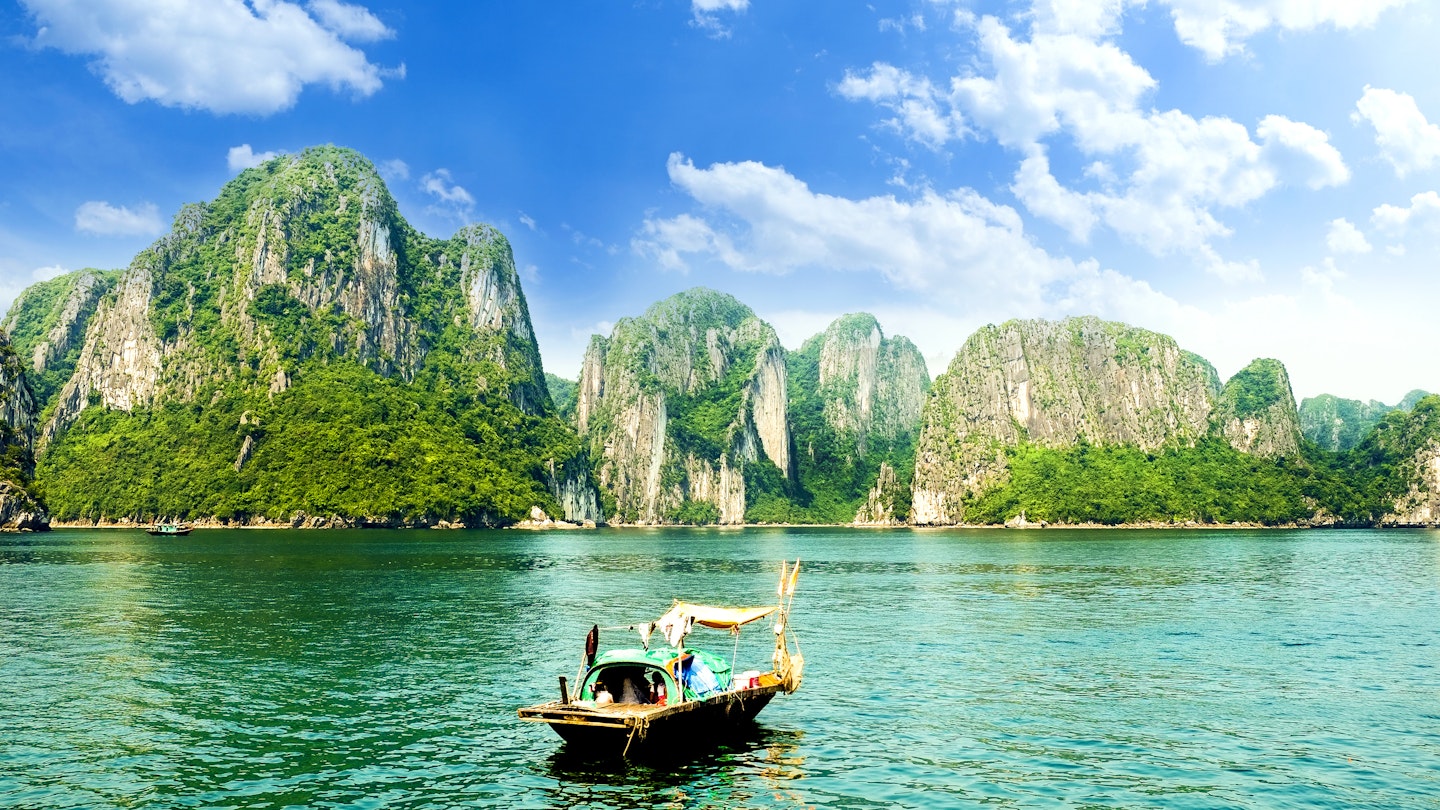Breathtaking landscapes appear at every turn in Vietnam. From the window of a trundling train, you’ll witness an endless patchwork of impossible-green rice paddies. In Halong Bay, a horizon studded with incisor-like limestone islands makes for an ethereal sight. From Mui Ne in the deep south, where you can marvel at the Sahara-esque scene of wind-sculpted sand dunes from the basket of a hot-air balloon, to the stupendous karst mountains of the far north, Vietnam offers a bewitching array of superlative landscapes.
Halong Bay
Halong Bay’s stunning combination of karst limestone peaks and sheltered, shimmering seas is one of Vietnam’s top tourist draws, featuring over 2000 different islands showcasing superb scenery. Therefore, it is definitely recommended to opt for an overnight cruise to fully experience this World Heritage wonder. Rise early for an ethereal misty dawn or pilot a kayak into grottoes and lagoons. For those seeking more karst beauty, consider visiting the less touristy yet equally spectacular Lan Ha Bay. Most tourists tend to do a one-night cruise, but if you can, consider extending it to 2 or even 3 nights to enjoy more activities such as kayaking, hiking, and swimming.
Phong Nha-Ke Bang National Park
With jagged hills shrouded in rainforest and mountain rivers coursing through impressive ravines, the Phong Nha-Ke Bang region is one of Vietnam’s most spectacular national parks. Explore the underground marvels as this area deserves a place in any Vietnamese itinerary. A fortunate selection of travelers can experience the cathedral-like chambers of Hang Son Doong, the world’s largest cave. For more accessible adventures, enjoy ziplining and kayaking thrills at Hang Toi (Dark Cave) or soak in the other-worldly beauty of Paradise Cave.

Hang Son Doong
Hang Son Doong (Mountain River Cave) is known as the world’s largest cave, and it stands as one of the most impressive sights in Southeast Asia, with its discovery officially recognized by the government in 2013. This enormous cave was discovered quite recently by Ho Khanh, a hunter from a jungle settlement close to the Vietnam–Laos border. He often took shelter in caves but stumbled across the breathtaking Hang Son Doong in the early 1990s. The sheer scale and majesty of this cavern, confirmed in 2009 by British explorers as the world’s largest, stretches over 5km (3.1mi) long, 200m high (656ft), and, in some places, reaches 150m (492ft) wide.
Phu Quoc Island
Surrounded by azure waters and bordered by pristine white-sand beaches, Phu Quoc, located in the southern part of Vietnam, is ideal for a hassle-free beach getaway. Enjoy a seaside cocktail while watching the sun dip into the sea. Moreover, over 70% of the island is a lush national park, offering opportunities for biking adventures along its red-dirt roads, as the island is relatively compact, comparable in size to Singapore.
Tonkinese Alps
The spectacular Tonkinese Alps soar along the rugged edges of Vietnam. This region includes Fansipan, the country’s highest peak, while sinuous and spidery ridges cascade down into the river valleys, home to vibrant ethnic minority villages such as the Hmong, Red Dzao, and Giay peoples.

Ban Gioc Waterfall
Ban Gioc is among Vietnam’s most famous waterfalls, with its image frequently adorning the lobby of numerous guesthouses. The falls, fed by the Quay Son River, which marks the border with China, are an impressive sight located in a highly scenic area. Therefore, aim to visit around lunchtime when the upstream dam is opened to allow for full flow.
Additionally, boat owners provide rides on bamboo rafts (for a small fee) allowing visitors to get close enough to feel the spray of the waterfall. The rafts on the Vietnamese side feature blue canopies, while those on the Chinese side have green canopies.
Sao Beach
With its idyllic white sand, the stunning curve of Sao Beach merges harmoniously with a crystal-clear sea just a few miles from An Thoi, the main shipping port at the southern tip of the island. There are a couple of beachfront restaurants where visitors can relax into deckchairs, change into swimwear, or partake in exciting water sports.

Ba Be National Park
Step off the typical tourist trail to discover Ba Be National Park, a must-visit destination for adventurous travelers. This park boasts towering limestone mountains, plunging valleys, and verdant evergreen forests. Waterfalls, caves, and lakes create a landscape that sustains over 550 different plant species alongside hundreds of bird and animal species. Explore Ba Be’s natural spectacle by boat or embark on trekking and mountain-biking excursions, before unwinding in rustic homestays and guesthouses within the local Tay ethnic community.
Thuy Son
Thuy Son is the largest and most renowned of the five Marble Mountains, hosting numerous natural caves where first Hindu and later Buddhist sanctuaries have been built over centuries. Among the two paths leading up the mountain, the one closer to the beach presents a better circuit. At the top of the staircase sits Ong Chon Gate, which is pockmarked with bullet holes, leading to Linh Ong Pagoda.
Mui Ne is globally recognized for its enormous red and white sand dunes. The smaller “red dunes” (doi hong) are conveniently situated north of the main strip, while the “white dunes” (doi cat trang), located 24km (14.9mi) northeast, showcase the most breathtaking scenery as the constant ocean winds sculpt the pale-yellow sands into stunning formations reminiscent of a desert landscape. However, being in Vietnam, the area rarely offers the silence commonly associated with deserts.
Be prepared for children enticing visitors to hire plastic sledges for riding down the dunes, though unless you weigh very little, it can be challenging to travel far this way.




